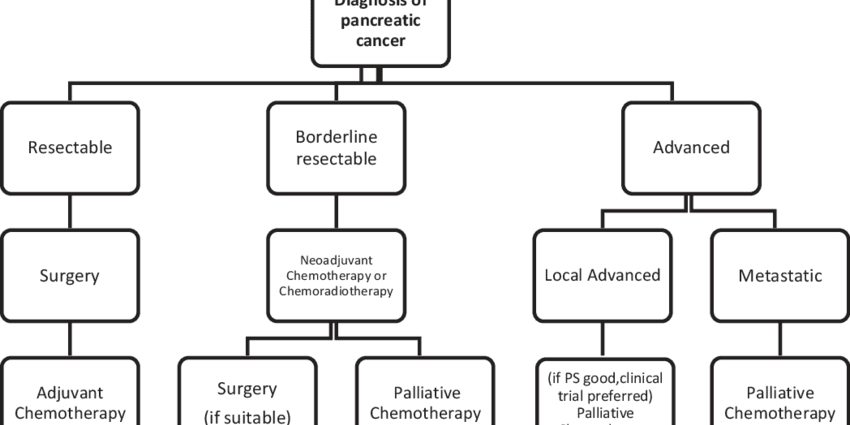Contents
Complementary treatments and approaches for pancreatic cancer
The treatments chosen vary according to the stage of the tumor, its location, its aggressiveness and its extension to lymph nodes, neighboring or distant organs (metastases)
Surgery is for tumors that have not metastasized, limited to the pancreas or at least that have not invaded the large vessels. It is not possible when the tumor is spread to neighboring organs, which would expose a too great risk during the operation. When surgery is not possible, the medical team may resort to chemotherapy or radiation therapy.
The choice of treatment is discussed in multidisciplinary consultation bringing together gastroenterologist, surgeon, oncologist, radiotherapist… .etc. The final decision is made in agreement with the sick person.
surgery
The type of intervention differs depending on the location of the tumor, head, body or tail of the pancreas. It removes the part of the pancreas affected by the tumor, as well as, depending on the case, part of the small intestine, the stomach, the gall bladder or the spleen.
These are major interventions requiring that the person’s state of health is otherwise good.
- Whipple’s Operation : this is the surgical procedure performed in the case of a tumor in the right end of the pancreas, linked to the small intestine, called the “head”. It involves removing the head of the pancreas as well as the gall bladder, part of the stomach and small intestine and the lymph nodes located nearby. It is a major surgery which involves reconstruction of the digestive tract;
- Distal pancreatectomy : If the tumor is located elsewhere than in the head of the pancreas, it is sometimes possible to remove the affected part. If necessary, the surgeon also removes the spleen;
- Total pancreatectomy : This very rare procedure involves removing the entire pancreas, as well as part of the stomach and small intestine, the spleen, the gall bladder and the lymph nodes.
Sometimes a tumor that you thought could be removed entirely (based on various medical examinations performed before surgery) ultimately cannot be. The surgeon can only confirm this at the start of surgery.
As the tumor grows, it can compress nearby organs:
– Sometimes the tumor compresses the ducts through which the bile passes. In the event of compression of these bile ducts, the surgeon may bypass the bile ducts in the small intestine or put in place prostheses to restore their diameter.
– When the tumor compresses the duodenum, it can prevent the passage of the bolus of food from the stomach to the intestine, it is possible to divert the stomach directly to the small intestine.
La convalescence after surgery is often difficult, especially if there has been reconstruction of the digestive tract. The operated person sometimes has to spend several days in intensive care. She is first fed intravenously or through a tube directly connected to the intestine. Thereafter, the diet must be adapted.
It takes several days for the digestive system to resume its normal functioning. Thereafter, the prescription of pancreatic enzymes may be indicated, as well as that of insulin in the event of diabetes. Indeed, when he removes the entire pancreas, the surgeon removes the tumor, but also the cells that produce insulin.
Chemotherapy
Chemotherapy is a treatment administered intravenously or orally to destroy cancer cells. It does not spare certain healthy cells either, hence the effects secondary, nausea, vomiting, fatigue, loss of appetite, hair loss and increased risk of infection.
In the case of pancreatic cancer, the medical team may use chemotherapy after surgery to eliminate cancer cells that may have persisted, or to prevent a recurrence. Chemotherapy may also be used to limit the progression of the disease or to ease symptoms if a tumor cannot be removed.
Radiotherapy
Radiation therapy is rarely used in the treatment of pancreatic cancer. It involves sending radiation to a specific location in the body to destroy cancer cells that have formed there. Radiation therapy for a tumor in the pancreas can cause diarrhea, indigestion, or nausea. The side effects of radiation therapy wear off after treatment, when healthy cells have regenerated. It can help reduce abdominal pain.
Monitoring of pancreatic cancer
The monitoring of the tumor after surgery is done on the scanner and the dosage of tumor markers
Treatment with pancreatic enzymes and insulin may be necessary depending on the type of surgery that has been performed.
Pain treatment and dietary approach
Whatever treatment is chosen, the wide choice of painkillers (analgesics) makes it possible to cope with pain associated with the tumor or its treatments.
The greatest attention is paid to the management of feeding problems before and after treatment in order to promote healing and post-operative recovery.
Complementary approaches
Reviews. Consult our Cancer file to learn about all the complementary approaches that have been studied in people with cancer, such as acupuncture, visualization, massage therapy and yoga. These approaches may be suitable when used in complement medical treatment, and not as a substitute for it.










